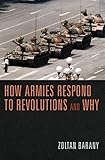How Armies Respond to Revolutions and Why / Zoltan Barany.
Material type: TextPublisher: Princeton, NJ : Princeton University Press, [2016]Copyright date: ©2016Description: 1 online resource (248 p.) : 6 tablesContent type:
TextPublisher: Princeton, NJ : Princeton University Press, [2016]Copyright date: ©2016Description: 1 online resource (248 p.) : 6 tablesContent type: - 9780691157368
- 9781400880997
- Comparative government
- Military policy -- Decision making -- Case studies
- Revolutions -- History -- 21st century -- Case studies
- World politics -- 1989-
- POLITICAL SCIENCE / Security (National & International)
- Arab republics
- Arab-majority states
- Ayatollah Ruhollah Khomeini
- Burma
- China
- Communism
- Eastern Europe
- Four Eight Uprising
- IAF
- Imperial Armed Forces
- Iran
- Iranian military
- Islamic Revolution
- Middle East
- Mohammad Reza Shah Pahlavi
- Ne Win
- North Africa
- People Power Uprising
- Romania
- Saffron Revolution
- Warsaw Pact
- armed forces
- army response
- civil-military relations
- civilЭilitary relations
- conscript army
- controlling unrest
- democratization
- domestic revolt
- domestic uprising
- empirical analysis
- explanatory factors
- external environment
- foreign intervention
- military cohesion
- military decision-making
- military establishment
- military regimes
- military response
- military
- political dynamics
- political upheavals
- popular uprisings
- protests
- regime change
- regime coercion
- regime legitimacy
- regular army
- revolution
- revolutions
- society
- state
- volunteer army
- 355.0218 23
- UA11 .B29 2018
- online - DeGruyter
- Issued also in print.
| Item type | Current library | Call number | URL | Status | Notes | Barcode | |
|---|---|---|---|---|---|---|---|
 eBook
eBook
|
Biblioteca "Angelicum" Pont. Univ. S.Tommaso d'Aquino Nuvola online | online - DeGruyter (Browse shelf(Opens below)) | Online access | Not for loan (Accesso limitato) | Accesso per gli utenti autorizzati / Access for authorized users | (dgr)9781400880997 |
Frontmatter -- Contents -- Tables -- Acknowledgments -- How Armies Respond to Revolutions and Why -- Introduction -- 1. What Determines the Army's Reaction to an Uprising? -- 2. Iran, 1979 -- 3. Burma, 1988 and 2007 -- 4. China and Eastern Europe, 1989 -- 5. The Middle East and North Africa, 2011 -- Conclusion -- Notes -- Bibliography -- Index
restricted access online access with authorization star
http://purl.org/coar/access_right/c_16ec
We know that a revolution's success largely depends on the army's response to it. But can we predict the military's reaction to an uprising? How Armies Respond to Revolutions and Why argues that it is possible to make a highly educated guess-and in some cases even a confident prediction-about the generals' response to a domestic revolt if we know enough about the army, the state it is supposed to serve, the society in which it exists, and the external environment that affects its actions. Through concise case studies of modern uprisings in Iran, China, Eastern Europe, Burma, and the Arab world, Zoltan Barany looks at the reasons for and the logic behind the variety of choices soldiers ultimately make.Barany offers tools-in the form of questions to be asked and answered-that enable analysts to provide the most informed assessment possible regarding an army's likely response to a revolution and, ultimately, the probable fate of the revolution itself. He examines such factors as the military's internal cohesion, the regime's treatment of its armed forces, and the size, composition, and nature of the demonstrations.How Armies Respond to Revolutions and Why explains how generals decide to support or suppress domestic uprisings.
Issued also in print.
Mode of access: Internet via World Wide Web.
In English.
Description based on online resource; title from PDF title page (publisher's Web site, viewed 29. Jul 2021)


